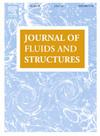An enhanced SPH-based hydroelastic FSI solver with structural dynamic hourglass control
IF 3.4
2区 工程技术
Q1 ENGINEERING, MECHANICAL
引用次数: 0
Abstract
This paper presents an enhanced hydroelastic FSI (Fluid-Structure Interaction) solver based on the open-source SPH (Smoothed Particle Hydrodynamics) code DualSPHysics+. For the structure model, a second-order discretization of the deformation gradient tensor (F2nd) is implemented to improve the accuracy of stress and strain computation. To mitigate numerical noises in the reproduced stress fields and improve numerical stability, a Riemann Stabilization (RS) term is incorporated in the structural momentum equation. A Dynamic Hourglass Control (DHGC) scheme being parameter-free is proposed to mitigate the spurious zero-energy modes linked with rank deficiency as a challenging issue for collocated computational methods including the total Lagrangian SPH. The novelty of this scheme is that it dynamically adjusts the hourglass control coefficient based on the instantaneous state of particle distributions and time evolution of an error function. For the fluid model, the Velocity divergence Error Mitigating (VEM) scheme and Hyperbolic/Parabolic Divergence Cleaning (HPDC) scheme are adopted to suppress spurious fluid pressure noises and hence enhance the modelling of fluid-structure interactions. Validations in terms of robustness and accuracy of the proposed model are carried out via five structure examples and three FSI ones. The results demonstrate that more physically consistent stress and strain fields are reproduced by the implementation of F2nd and RS. The proposed DHGC scheme effectively suppresses hourglass modes and is case- and resolution-independent (in contrast to the traditional Hourglass Control scheme). The incorporation of the VEM and HPDC mitigates fluid pressure noises and further enhances the accuracy of FSI simulations.

具有结构动态沙漏控制的基于sph的增强型水弹性FSI求解器
本文提出了一种基于开放源代码的光滑粒子流体力学(SPH)代码dualspphysics +的增强型水弹性流固耦合(FSI)求解器。为了提高结构模型的应力应变计算精度,对变形梯度张量(f2)进行了二阶离散化处理。为了减轻再现应力场中的数值噪声,提高数值稳定性,在结构动量方程中加入了Riemann稳定化项。提出了一种无参数的动态沙漏控制(DHGC)方案,以缓解与秩缺乏相关的虚假零能量模式,这是包括总拉格朗日SPH在内的共配计算方法的一个挑战。该方案的新颖之处在于根据粒子分布的瞬时状态和误差函数的时间演化动态调整沙漏控制系数。对于流体模型,采用速度散度误差缓解(VEM)方案和双曲/抛物散度清洗(HPDC)方案来抑制虚假流体压力噪声,从而增强流固耦合的建模能力。通过5个结构算例和3个FSI算例对模型的鲁棒性和准确性进行了验证。结果表明,采用F2nd和RS可获得物理上更一致的应力和应变场。与传统的沙漏控制方案相比,DHGC方案有效地抑制了沙漏模式,并且与情况和分辨率无关。VEM和HPDC的结合降低了流体压力噪声,进一步提高了FSI模拟的精度。
本文章由计算机程序翻译,如有差异,请以英文原文为准。
求助全文
约1分钟内获得全文
求助全文
来源期刊

Journal of Fluids and Structures
工程技术-工程:机械
CiteScore
6.90
自引率
8.30%
发文量
173
审稿时长
65 days
期刊介绍:
The Journal of Fluids and Structures serves as a focal point and a forum for the exchange of ideas, for the many kinds of specialists and practitioners concerned with fluid–structure interactions and the dynamics of systems related thereto, in any field. One of its aims is to foster the cross–fertilization of ideas, methods and techniques in the various disciplines involved.
The journal publishes papers that present original and significant contributions on all aspects of the mechanical interactions between fluids and solids, regardless of scale.
 求助内容:
求助内容: 应助结果提醒方式:
应助结果提醒方式:


